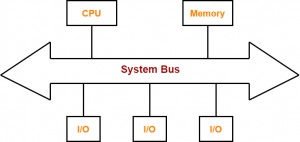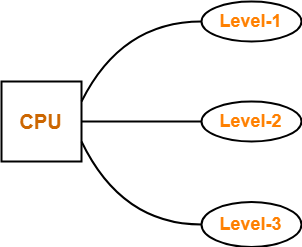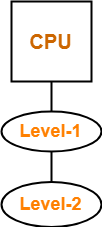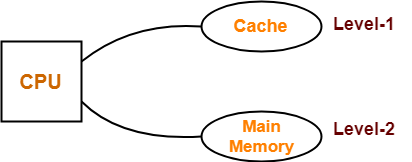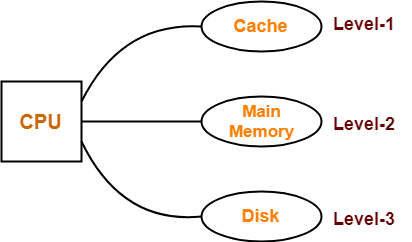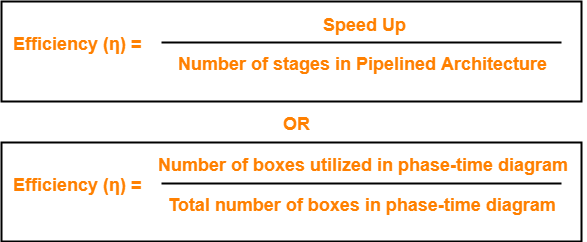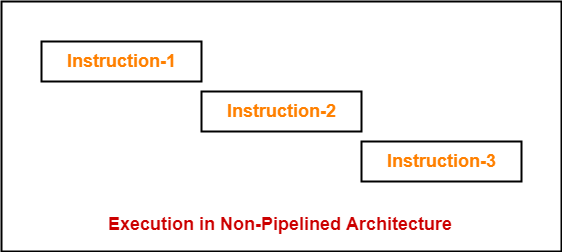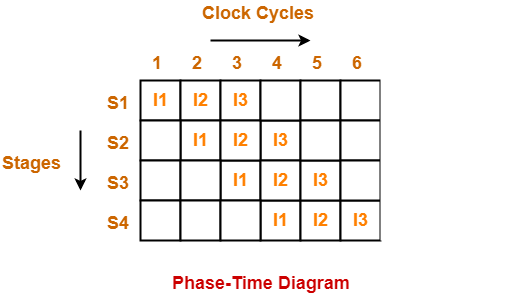Pipelining in Computer Architecture-
Before you go through this article, make sure that you have gone through the previous article on Instruction Pipelining.
In instruction pipelining,
- A form of parallelism called as instruction level parallelism is implemented.
- Multiple instructions execute simultaneously.
- Speed up, Efficiency and Throughput serve as performance measures of pipelined execution.
Also Read- Performance Criteria Of Pipelining
In this article, we will discuss practice problems based on pipelining.
PRACTICE PROBLEMS BASED ON PIPELINING IN COMPUTER ARCHITECTURE-
Problem-01:
Consider a pipeline having 4 phases with duration 60, 50, 90 and 80 ns. Given latch delay is 10 ns. Calculate-
- Pipeline cycle time
- Non-pipeline execution time
- Speed up ratio
- Pipeline time for 1000 tasks
- Sequential time for 1000 tasks
- Throughput
Solution-
Given-
- Four stage pipeline is used
- Delay of stages = 60, 50, 90 and 80 ns
- Latch delay or delay due to each register = 10 ns
Part-01: Pipeline Cycle Time-
Cycle time
= Maximum delay due to any stage + Delay due to its register
= Max { 60, 50, 90, 80 } + 10 ns
= 90 ns + 10 ns
= 100 ns
Part-02: Non-Pipeline Execution Time-
Non-pipeline execution time for one instruction
= 60 ns + 50 ns + 90 ns + 80 ns
= 280 ns
Part-03: Speed Up Ratio-
Speed up
= Non-pipeline execution time / Pipeline execution time
= 280 ns / Cycle time
= 280 ns / 100 ns
= 2.8
Part-04: Pipeline Time For 1000 Tasks-
Pipeline time for 1000 tasks
= Time taken for 1st task + Time taken for remaining 999 tasks
= 1 x 4 clock cycles + 999 x 1 clock cycle
= 4 x cycle time + 999 x cycle time
= 4 x 100 ns + 999 x 100 ns
= 400 ns + 99900 ns
= 100300 ns
Part-05: Sequential Time For 1000 Tasks-
Non-pipeline time for 1000 tasks
= 1000 x Time taken for one task
= 1000 x 280 ns
= 280000 ns
Part-06: Throughput-
Throughput for pipelined execution
= Number of instructions executed per unit time
= 1000 tasks / 100300 ns
Problem-02:
A four stage pipeline has the stage delays as 150, 120, 160 and 140 ns respectively. Registers are used between the stages and have a delay of 5 ns each. Assuming constant clocking rate, the total time taken to process 1000 data items on the pipeline will be-
- 120.4 microseconds
- 160.5 microseconds
- 165.5 microseconds
- 590.0 microseconds
Solution-
Given-
- Four stage pipeline is used
- Delay of stages = 150, 120, 160 and 140 ns
- Delay due to each register = 5 ns
- 1000 data items or instructions are processed
Cycle Time-
Cycle time
= Maximum delay due to any stage + Delay due to its register
= Max { 150, 120, 160, 140 } + 5 ns
= 160 ns + 5 ns
= 165 ns
Pipeline Time To Process 1000 Data Items-
Pipeline time to process 1000 data items
= Time taken for 1st data item + Time taken for remaining 999 data items
= 1 x 4 clock cycles + 999 x 1 clock cycle
= 4 x cycle time + 999 x cycle time
= 4 x 165 ns + 999 x 165 ns
= 660 ns + 164835 ns
= 165495 ns
= 165.5 μs
Thus, Option (C) is correct.
Problem-03:
Consider a non-pipelined processor with a clock rate of 2.5 gigahertz and average cycles per instruction of 4. The same processor is upgraded to a pipelined processor with five stages but due to the internal pipeline delay, the clock speed is reduced to 2 gigahertz. Assume there are no stalls in the pipeline. The speed up achieved in this pipelined processor is-
- 3.2
- 3.0
- 2.2
- 2.0
Solution-
Cycle Time in Non-Pipelined Processor-
Frequency of the clock = 2.5 gigahertz
Cycle time
= 1 / frequency
= 1 / (2.5 gigahertz)
= 1 / (2.5 x 109 hertz)
= 0.4 ns
Non-Pipeline Execution Time-
Non-pipeline execution time to process 1 instruction
= Number of clock cycles taken to execute one instruction
= 4 clock cycles
= 4 x 0.4 ns
= 1.6 ns
Cycle Time in Pipelined Processor-
Frequency of the clock = 2 gigahertz
Cycle time
= 1 / frequency
= 1 / (2 gigahertz)
= 1 / (2 x 109 hertz)
= 0.5 ns
Pipeline Execution Time-
Since there are no stalls in the pipeline, so ideally one instruction is executed per clock cycle. So,
Pipeline execution time
= 1 clock cycle
= 0.5 ns
Speed Up-
Speed up
= Non-pipeline execution time / Pipeline execution time
= 1.6 ns / 0.5 ns
= 3.2
Thus, Option (A) is correct.
Problem-04:
The stage delays in a 4 stage pipeline are 800, 500, 400 and 300 picoseconds. The first stage is replaced with a functionally equivalent design involving two stages with respective delays 600 and 350 picoseconds.
The throughput increase of the pipeline is _____%.
Solution-
Execution Time in 4 Stage Pipeline-
Cycle time
= Maximum delay due to any stage + Delay due to its register
= Max { 800, 500, 400, 300 } + 0
= 800 picoseconds
Thus, Execution time in 4 stage pipeline = 1 clock cycle = 800 picoseconds.
Throughput in 4 Stage Pipeline-
Throughput
= Number of instructions executed per unit time
= 1 instruction / 800 picoseconds
Execution Time in 2 Stage Pipeline-
Cycle time
= Maximum delay due to any stage + Delay due to its register
= Max { 600, 350 } + 0
= 600 picoseconds
Thus, Execution time in 2 stage pipeline = 1 clock cycle = 600 picoseconds.
Throughput in 2 Stage Pipeline-
Throughput
= Number of instructions executed per unit time
= 1 instruction / 600 picoseconds
Throughput Increase-
Throughput increase
= { (Final throughput – Initial throughput) / Initial throughput } x 100
= { (1 / 600 – 1 / 800) / (1 / 800) } x 100
= { (800 / 600) – 1 } x 100
= (1.33 – 1) x 100
= 0.3333 x 100
= 33.33 %
Problem-05:
A non-pipelined single cycle processor operating at 100 MHz is converted into a synchronous pipelined processor with five stages requiring 2.5 ns, 1.5 ns, 2 ns, 1.5 ns and 2.5 ns respectively. The delay of the latches is 0.5 sec.
The speed up of the pipeline processor for a large number of instructions is-
- 4.5
- 4.0
- 3.33
- 3.0
Solution-
Cycle Time in Non-Pipelined Processor-
Frequency of the clock = 100 MHz
Cycle time
= 1 / frequency
= 1 / (100 MHz)
= 1 / (100 x 106 hertz)
= 0.01 μs
Non-Pipeline Execution Time-
Non-pipeline execution time to process 1 instruction
= Number of clock cycles taken to execute one instruction
= 1 clock cycle
= 0.01 μs
= 10 ns
Cycle Time in Pipelined Processor-
Cycle time
= Maximum delay due to any stage + Delay due to its register
= Max { 2.5, 1.5, 2, 1.5, 2.5 } + 0.5 ns
= 2.5 ns + 0.5 ns
= 3 ns
Pipeline Execution Time-
Pipeline execution time
= 1 clock cycle
= 3 ns
Speed Up-
Speed up
= Non-pipeline execution time / Pipeline execution time
= 10 ns / 3 ns
= 3.33
Thus, Option (C) is correct.
Problem-06:
We have 2 designs D1 and D2 for a synchronous pipeline processor. D1 has 5 stage pipeline with execution time of 3 ns, 2 ns, 4 ns, 2 ns and 3 ns. While the design D2 has 8 pipeline stages each with 2 ns execution time. How much time can be saved using design D2 over design D1 for executing 100 instructions?
- 214 ns
- 202 ns
- 86 ns
- 200 ns
Solution-
Cycle Time in Design D1-
Cycle time
= Maximum delay due to any stage + Delay due to its register
= Max { 3, 2, 4, 2, 3 } + 0
= 4 ns
Execution Time For 100 Instructions in Design D1-
Execution time for 100 instructions
= Time taken for 1st instruction + Time taken for remaining 99 instructions
= 1 x 5 clock cycles + 99 x 1 clock cycle
= 5 x cycle time + 99 x cycle time
= 5 x 4 ns + 99 x 4 ns
= 20 ns + 396 ns
= 416 ns
Cycle Time in Design D2-
Cycle time
= Delay due to a stage + Delay due to its register
= 2 ns + 0
= 2 ns
Execution Time For 100 Instructions in Design D2-
Execution time for 100 instructions
= Time taken for 1st instruction + Time taken for remaining 99 instructions
= 1 x 8 clock cycles + 99 x 1 clock cycle
= 8 x cycle time + 99 x cycle time
= 8 x 2 ns + 99 x 2 ns
= 16 ns + 198 ns
= 214 ns
Time Saved-
Time saved
= Execution time in design D1 – Execution time in design D2
= 416 ns – 214 ns
= 202 ns
Thus, Option (B) is correct.
Problem-07:
Consider an instruction pipeline with four stages (S1, S2, S3 and S4) each with combinational circuit only. The pipeline registers are required between each stage and at the end of the last stage. Delays for the stages and for the pipeline registers are as given in the figure-
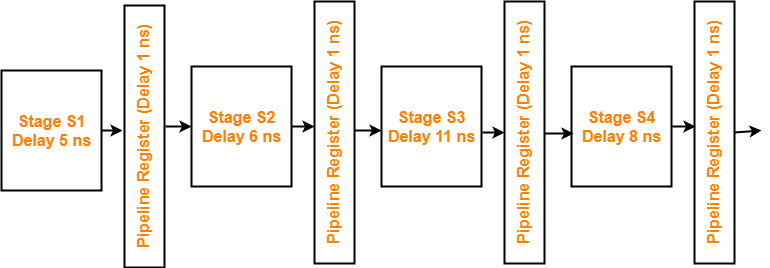
What is the approximate speed up of the pipeline in steady state under ideal conditions when compared to the corresponding non-pipeline implementation?
- 4.0
- 2.5
- 1.1
- 3.0
Solution-
Non-Pipeline Execution Time-
Non-pipeline execution time for 1 instruction
= 5 ns + 6 ns + 11 ns + 8 ns
= 30 ns
Cycle Time in Pipelined Processor-
Cycle time
= Maximum delay due to any stage + Delay due to its register
= Max { 5, 6, 11, 8 } + 1 ns
= 11 ns + 1 ns
= 12 ns
Pipeline Execution Time-
Pipeline execution time
= 1 clock cycle
= 12 ns
Speed Up-
Speed up
= Non-pipeline execution time / Pipeline execution time
= 30 ns / 12 ns
= 2.5
Thus, Option (B) is correct.
Problem-08:
Consider a 4 stage pipeline processor. The number of cycles needed by the four instructions I1, I2, I3 and I4 in stages S1, S2, S3 and S4 is shown below-
|
S1 |
S2 |
S3 |
S4 |
| I1 |
2 |
1 |
1 |
1 |
| I2 |
1 |
3 |
2 |
2 |
| I3 |
2 |
1 |
1 |
3 |
| I4 |
1 |
2 |
2 |
2 |
What is the number of cycles needed to execute the following loop?
for(i=1 to 2) { I1; I2; I3; I4; }
- 16
- 23
- 28
- 30
Solution-
The phase-time diagram is-

From here, number of clock cycles required to execute the loop = 23 clock cycles.
Thus, Option (B) is correct.
Problem-09:
Consider a pipelined processor with the following four stages-
IF : Instruction Fetch
ID : Instruction Decode and Operand Fetch
EX : Execute
WB : Write Back
The IF, ID and WB stages take one clock cycle each to complete the operation. The number of clock cycles for the EX stage depends on the instruction. The ADD and SUB instructions need 1 clock cycle and the MUL instruction need 3 clock cycles in the EX stage. Operand forwarding is used in the pipelined processor. What is the number of clock cycles taken to complete the following sequence of instructions?
ADD R2, R1, R0 R2 ← R0 + R1
MUL R4, R3, R2 R4 ← R3 + R2
SUB R6, R5, R4 R6 ← R5 + R4
- 7
- 8
- 10
- 14
Solution-
The phase-time diagram is-
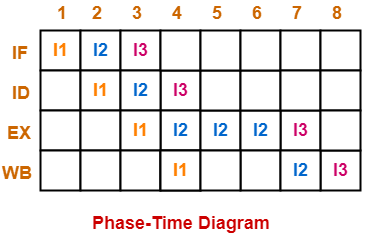
From here, number of clock cycles required to execute the instructions = 8 clock cycles.
Thus, Option (B) is correct.
Problem-10:
Consider the following procedures. Assume that the pipeline registers have zero latency.
P1 : 4 stage pipeline with stage latencies 1 ns, 2 ns, 2 ns, 1 ns
P2 : 4 stage pipeline with stage latencies 1 ns, 1.5 ns, 1.5 ns, 1.5 ns
P3 : 5 stage pipeline with stage latencies 0.5 ns, 1 ns, 1 ns, 0.6 ns, 1 ns
P4 : 5 stage pipeline with stage latencies 0.5 ns, 0.5 ns, 1 ns, 1 ns, 1.1 ns
Which procedure has the highest peak clock frequency?
- P1
- P2
- P3
- P4
Solution-
It is given that pipeline registers have zero latency. Thus,
Cycle time
= Maximum delay due to any stage + Delay due to its register
= Maximum delay due to any stage
For Processor P1:
Cycle time
= Max { 1 ns, 2 ns, 2 ns, 1 ns }
= 2 ns
Clock frequency
= 1 / Cycle time
= 1 / 2 ns
= 0.5 gigahertz
For Processor P2:
Cycle time
= Max { 1 ns, 1.5 ns, 1.5 ns, 1.5 ns }
= 1.5 ns
Clock frequency
= 1 / Cycle time
= 1 / 1.5 ns
= 0.67 gigahertz
For Processor P3:
Cycle time
= Max { 0.5 ns, 1 ns, 1 ns, 0.6 ns, 1 ns }
= 1 ns
Clock frequency
= 1 / Cycle time
= 1 / 1 ns
= 1 gigahertz
For Processor P4:
Cycle time
= Max { 0.5 ns, 0.5 ns, 1 ns, 1 ns, 1.1 ns }
= 1.1 ns
Clock frequency
= 1 / Cycle time
= 1 / 1.1 ns
= 0.91 gigahertz
Clearly, Process P3 has the highest peak clock frequency.
Thus, Option (C) is correct.
Problem-11:
Consider a 3 GHz (gigahertz) processor with a three-stage pipeline and stage latencies T1, T2 and T3 such that T1 = 3T2/4 = 2T3. If the longest pipeline stage is split into two pipeline stages of equal latency, the new frequency is ____ GHz, ignoring delays in the pipeline registers.
Solution-
Let ‘t’ be the common multiple of each ratio, then-
- T1 = t
- T2 = 4t / 3
- T3 = t / 2
Pipeline Cycle Time-
Pipeline cycle time
= Maximum delay due to any stage + Delay due to its register
= Max { t, 4t/3, t/2 } + 0
= 4t/3
Frequency Of Pipeline-
Frequency
= 1 / Pipeline cycle time
= 1 / (4t / 3)
= 3 / 4t
Given frequency = 3 GHz. So,
3 / 4t = 3 GHz
4t = 1 ns
t = 0.25 ns
Stage Latencies Of Pipeline-
Stage latency of different stages are-
- Latency of stage-01 = 0.25 ns
- Latency of stage-02 = 0.33 ns
- Latency of stage-03 = 0.125 ns
Splitting The Pipeline-
The stage with longest latency i.e. stage-02 is split up into 4 stages.
After splitting, the latency of different stages are-
- Latency of stage-01 = 0.25 ns
- Latency of stage-02 = 0.165 ns
- Latency of stage-03 = 0.165 ns
- Latency of stage-04 = 0.125 ns
Splitted Pipeline Cycle Time-
Splitted pipeline cycle time
= Maximum delay due to any stage + Delay due to its register
= Max { 0.25, 0.165, 0.165, 0.125 } + 0
= 0.25 ns
Frequency Of Splitted Pipeline-
Frequency
= 1 / splitted pipeline cycle time
= 1 / 0.25 ns
= 4 GHz
Thus, new frequency = 4 GHz.
Get more notes and other study material of Computer Organization and Architecture.
Watch video lectures by visiting our YouTube channel LearnVidFun.
